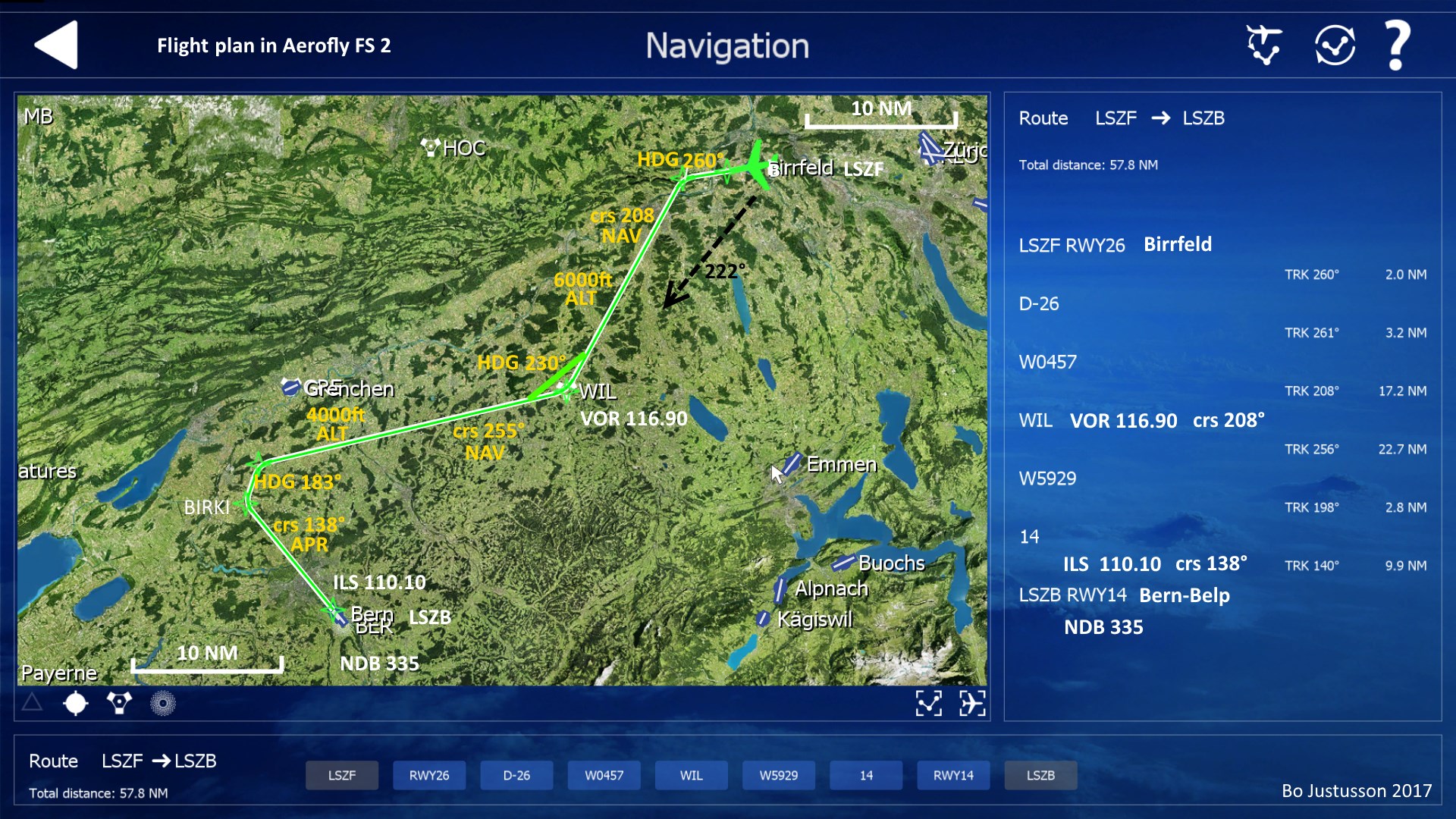King Air-series are twin-turboprop aircrafts.
They are faster and have higher climb rate
than cylinder-engined planes like Baron 58.
First King Air 90 was delivered in 1964.
King Air series is the most produced twin-turboprop business aircraft model.
It has glass-cockpit with Rockwell Collins Pro Line 21.
We will start by using only its basic autopilot functions.
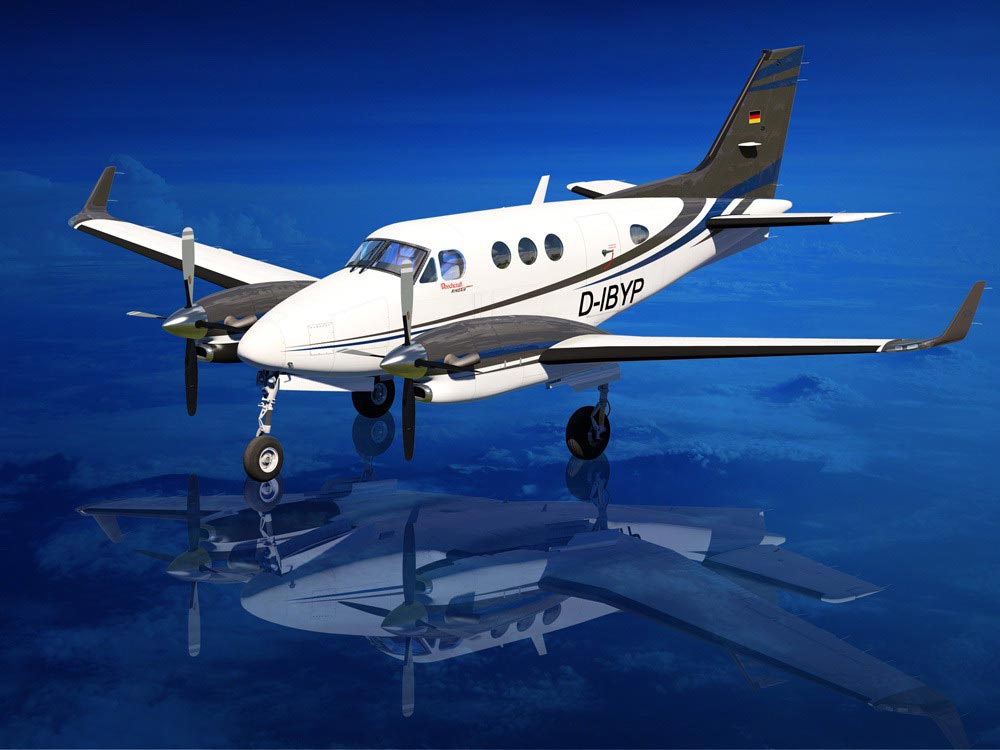
Speeds (V = Vitesse, fr)
Vrotate_____ 95 KIAS, knots, NM/h
Vcruise____ 220 kts --> 3.7 NM/min
Vappr_____ 150 kts
Vref_______100 kts - at threshold
Vs0________ 78 kts - stall when flaps+gear Out
climbVS___ 2000 ft/min (max)
|
Fig K1. Glass cockpit set-up for VOR-navigation - for manual flight or with autopilot
PFD Primary Flight Display: Speed, Horizon, Altitude, HSI, and lots of settings info.
MFD Multi Function Display - at present (9 Dec 2017) only one - no Weather, TopoMap, Hydraulics,..
It shows: Engine instruments, Checklist, HSI 130°-arc and map with flight plan + nav objects.
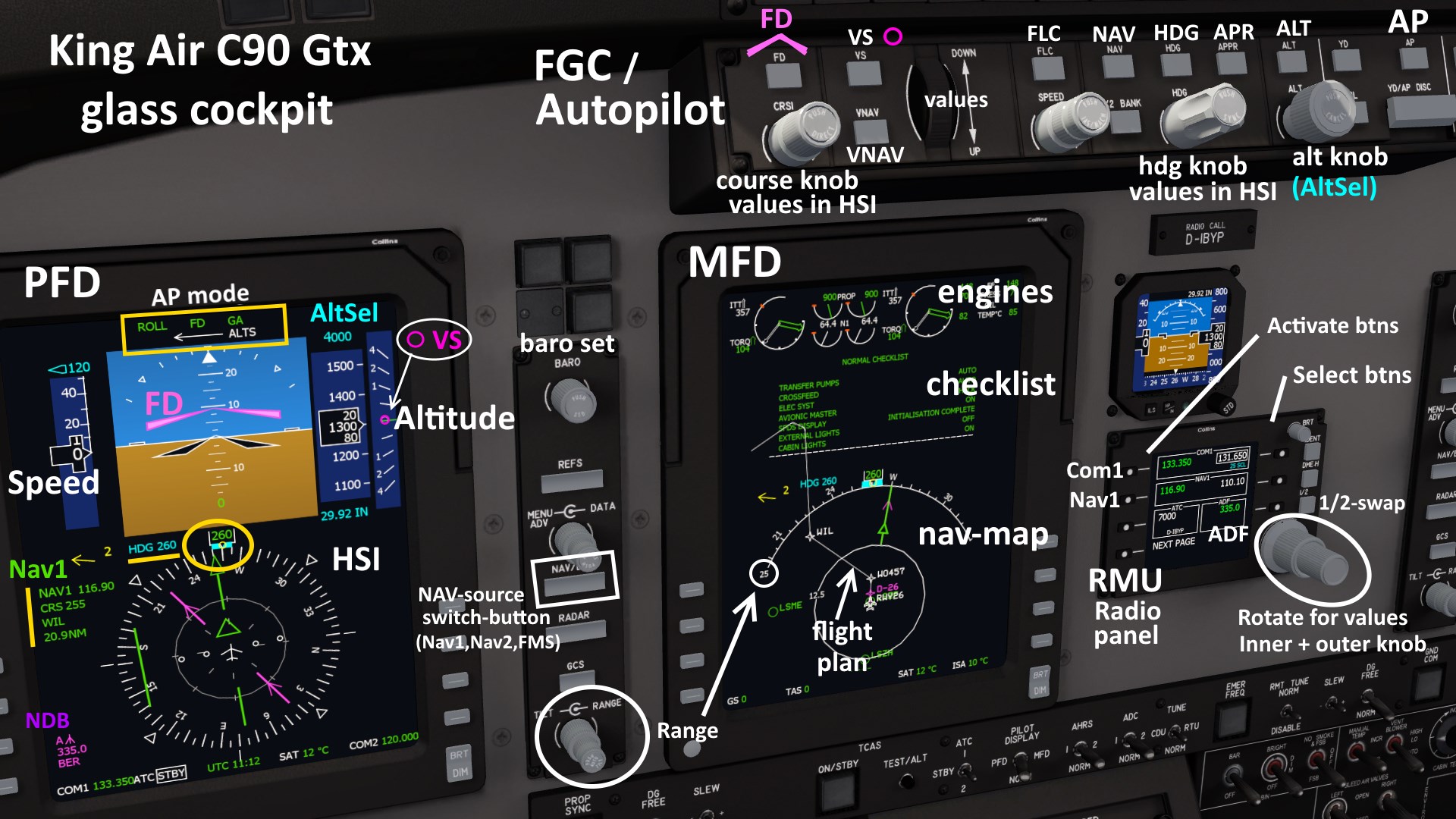
Knobs: mouse-rotate or click('press') to get standard- or now-values.
|
Now lets try the advanced functions: Our flight plan is in the FMS computer and autopilot will
do the lateral (horizontal) navigation all the way using GPS.
We must manage: start, altitude and speed, and ILS activation.
FMS Flight Management System, i.e. a computer with advanced functions
for system display and navigation.
Nav/Brg-button - lets you choose between:
* Nav1 - VOR1-nav or ILS1-nav.
* Nav2 - VOR2-nav or ILS2-nav.
* FMS - stored flight plan followed with GPS
Activate with AP's NAV-button.
- FD Flight Director - pink symbol that guides you if you want to fly manually along your flight plan.
"FD" text in PFD-top shows pilot in charge!
(Click on [FD]-btn in AP erases AP settings and activates Pitch+Roll-holding(?)
- Vnav Vertical Nav - three options possible:
* VS Vertical Speed, set to x ft/min
* SPEED click for present, then kept by nose up/dn
* FLC Flight Level Change - computer scheme.
No throttle control in this AP. You must manage!
- LNAV Lateral Nav - (horizontal nav).
We will try a FMS-guided tour. Settings as in Fig K2.
|
Fig K2. FMS activated, HSI green text! Autopilot will follow flight plan
- after take-off and click on NAV!
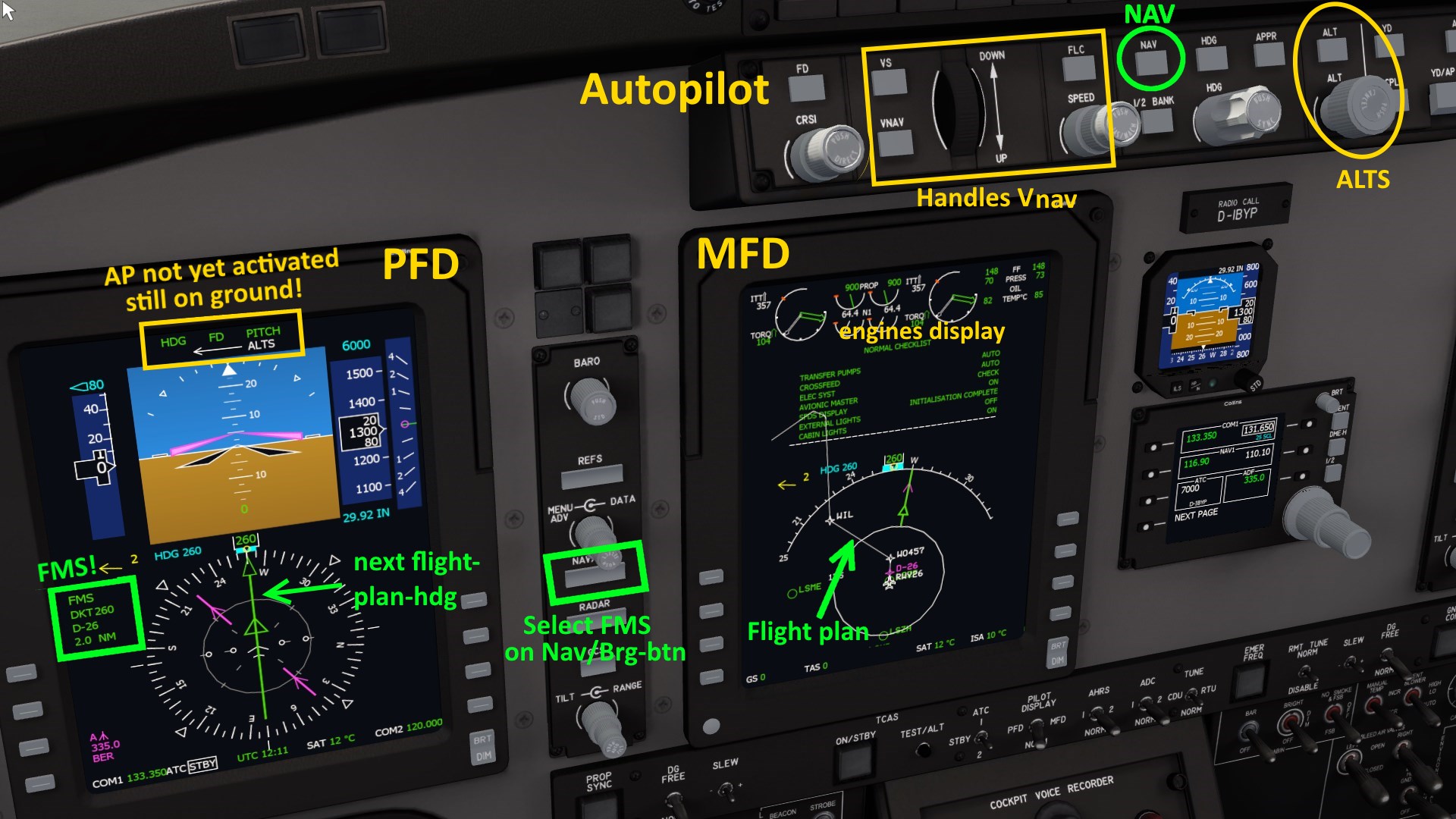
|
Tour Birrfeld to Bern with FMS - GPS-nav part
This sequence of images shows FMS in work.
We start with AP-off, i.e. in FD-mode.
After take-off and stabilizing we set AP on.
First only pitch and roll control.
Then click [NAV] to activate FMS - GPS-navigation!
We must select altitude: Alt-btn to 7000ft,
click [ALT] and quickly [VS] and rotate wheel UP to get 1000ft/min.
Then lean back and follow FMS handling climb to 7000ft (ALTS), and making our three turns.
- Notice changes in AP-mode on top line of PFD!
|
Started. AP on. First turn to the left. Climbing.
AP-mode: FMS AP FS/ALTS
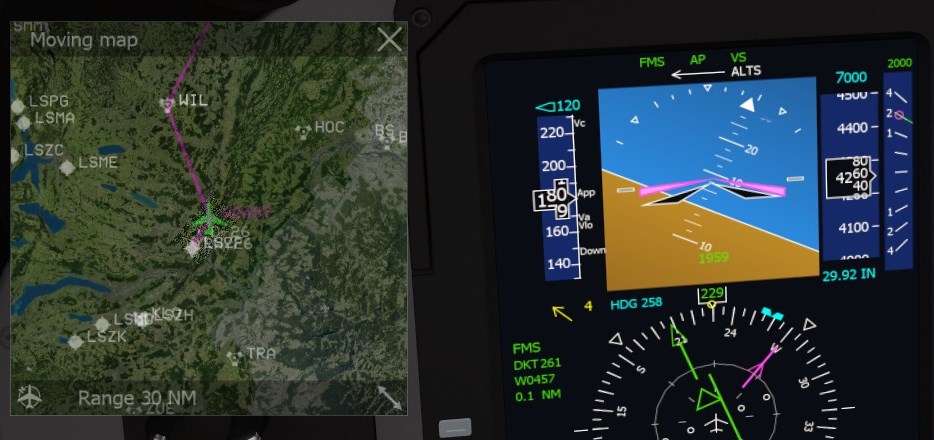
|
Turn to the right at WIL. Have reache ALTS 7000ft.
AP-mode: FMS AP ALTS (7200ft)
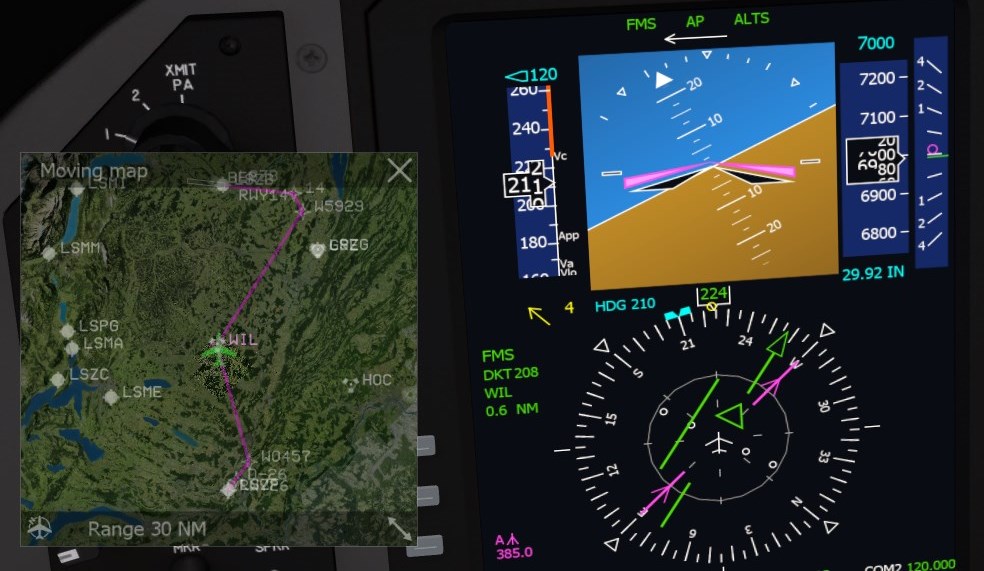
|
Catching ILS and landing
After turn 3 we want to catch Bern ILS-beam at 138°.
We have Nav1 frequency set to 110.10, and
must set crs to 138°. Sevaral ways to do that:
- Already at start.
- Set AP in HDG-mode, and Nav/Brg-btn to Nav1,
and turn crs1-knob.
- Let co-pilot make changes on PFD-2
(use key 2 and 1 to swap pilot-seat!)
We are on hdg 183° and can use [NAV] to catch beam (LOC).
Then to catch glide slope we use [APR].
If all goes well we will approach runway and
can let autopilot do a hard landing, or flare out when over threshold (AP off!).
I had difficulties handling speed well.
I ought to have memorized the V-speed above!
|
Moving in to ILS. Turn left. NAV with ILS i.e. slightly wider catch field.
AP-mode: VOR AP ALTS (now 4000ft)
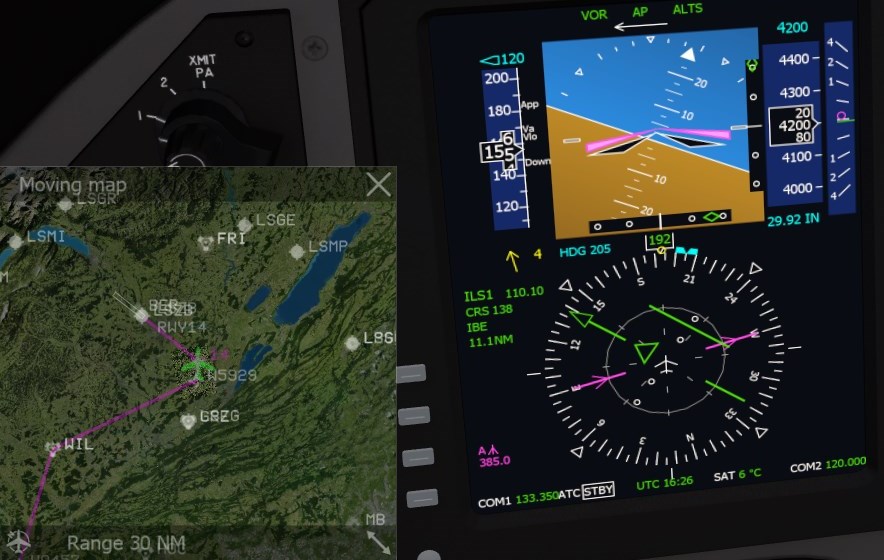 |
ILS both LOC heading 138° and GS glide slope (here 4°) caught.
AP-mode: LOC AP GS
Remark: Now NDB 335 BER is set, late!

Note the two Course Deviation Indicators, CDI, in the Attitude indicator:
Green diamonds on black stripes with white dots.

|
The airplanes above show a historical development: Cessna simple AP+old instruments,
Baron similar but with HSI, King Air with a modern glass cockpit.
In AFS2 next choices can be Learjet 45 or Dash 8Q-400. Both have APs similar to King Air.
- Learjet 45 is a very quick and agile, almost like a jet fighter. You should have a good joystick
and handle with tiny motions! Learjet's cockpit is compact and one
has a good view of all instruments in a sim-screen.
- Dash 8Q-400 turboprop is slower and moves more gently. But, its cockpit has panels wide apart,
making it difficult to use in sim-screen: when one turns a knob the changing digits are sometimes out of view.
AFS2 manuals
- The AFS2-manual for Airbus 320 is very pedagogic.
- The manuals for Learjet and Dash contain lots of info on what a real pilot has to handle,
which makes them a little difficult to read. Maybe will AFS2 split them into several parts (?).
|
Fig. Learjet 45 instruments. Compact design - good for Sim with screen display!
 Fig. You can choose different layouts in PFD and MFD. Here two PFD variants in Learjet:
Fig. You can choose different layouts in PFD and MFD. Here two PFD variants in Learjet:
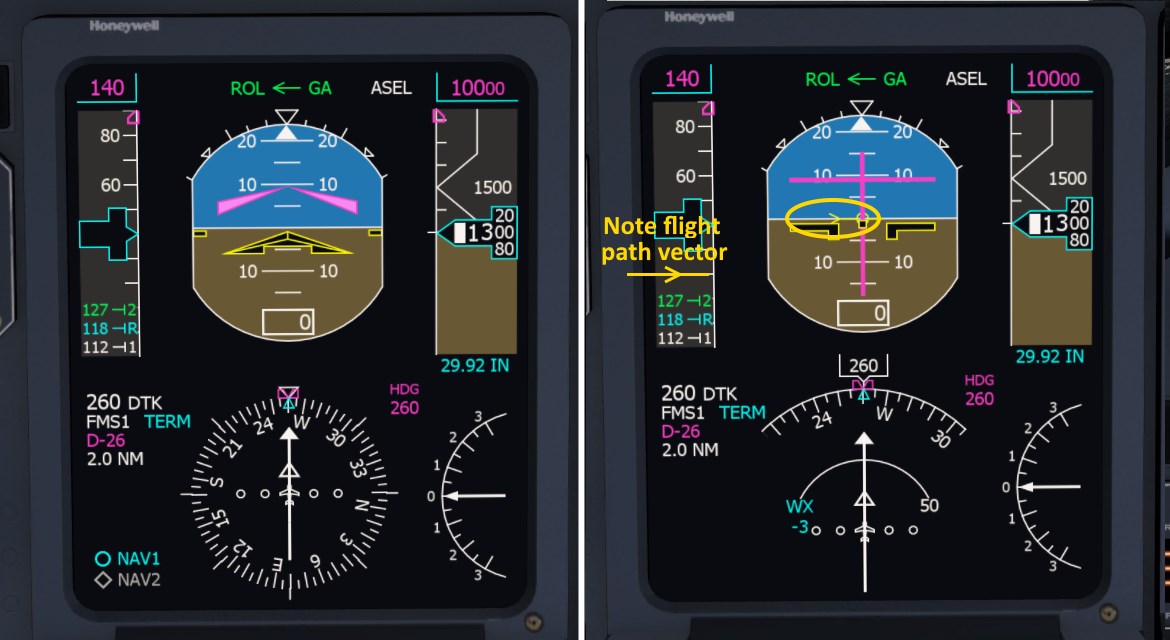
|
Fig. Dash 8Q-400 instruments. More spread-out. Requires zoom and pan in Sim!
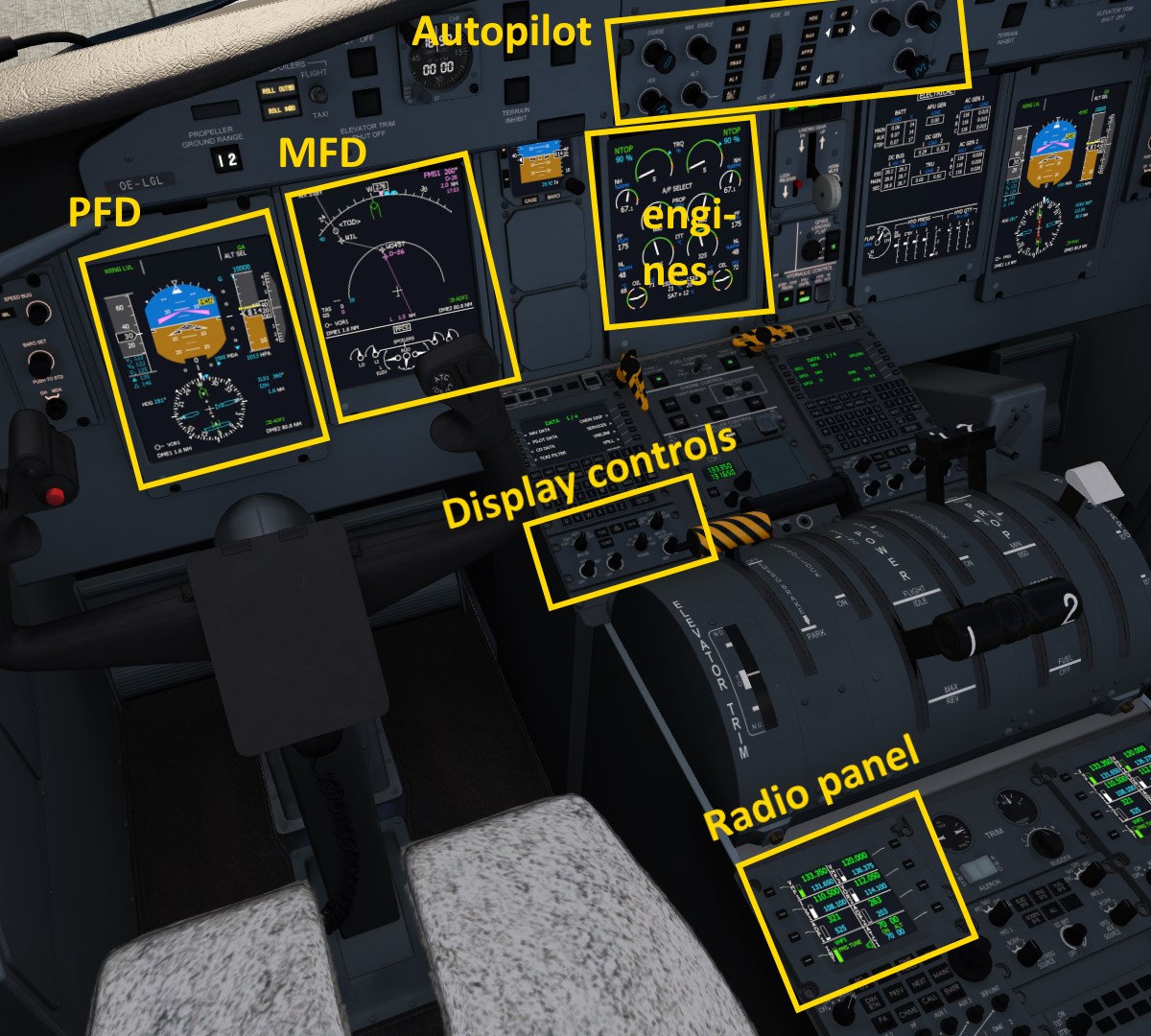
|
- Airbus 320 and Boeing 747 in AFS2 have modern autopilots that show digits close to each knob.
Fig. Detail of A320 display contol and autopilot

|
Fig. Airbus 320 in AFS2
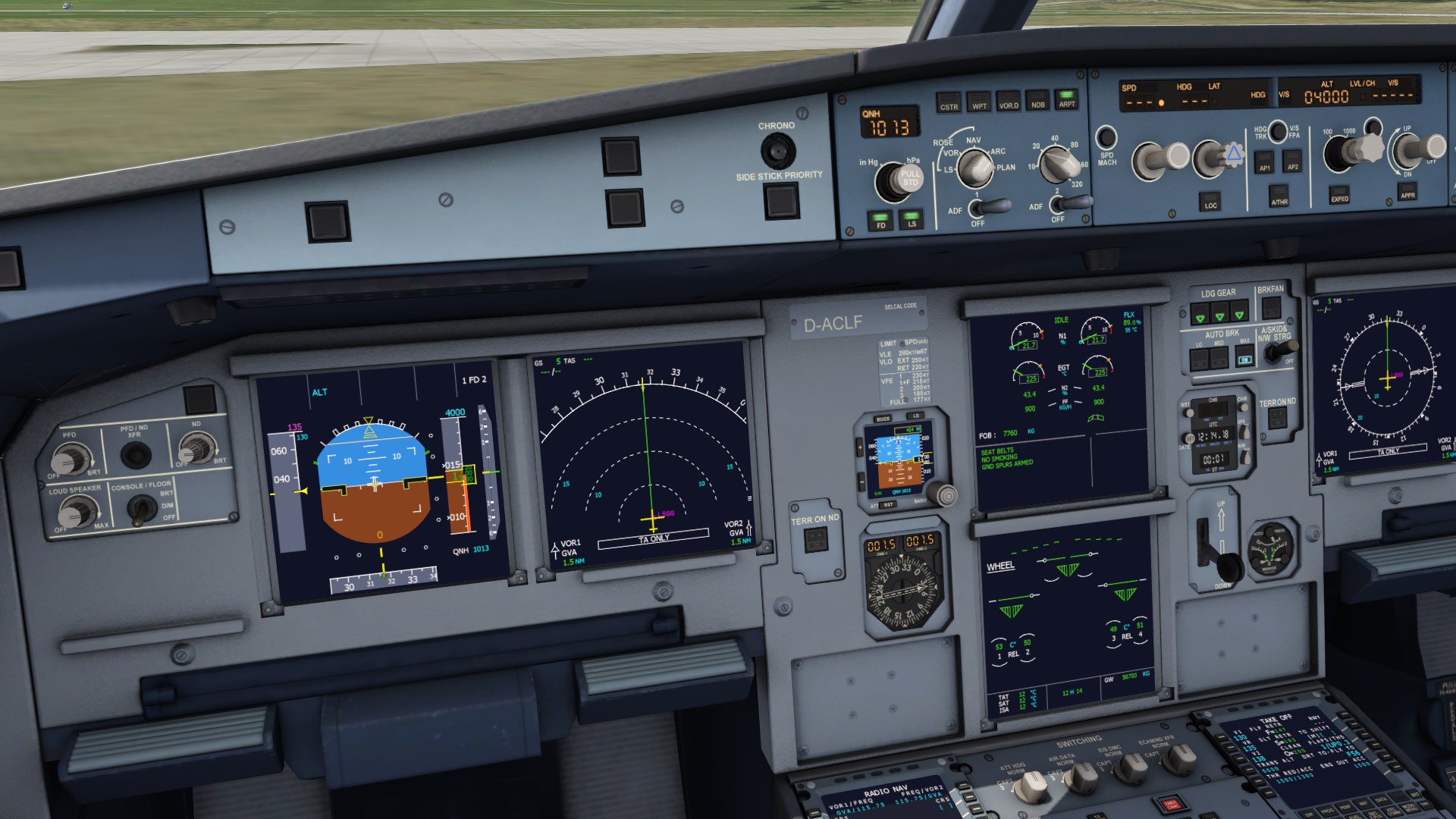
|
Fig. Boeing 747 in AFS2
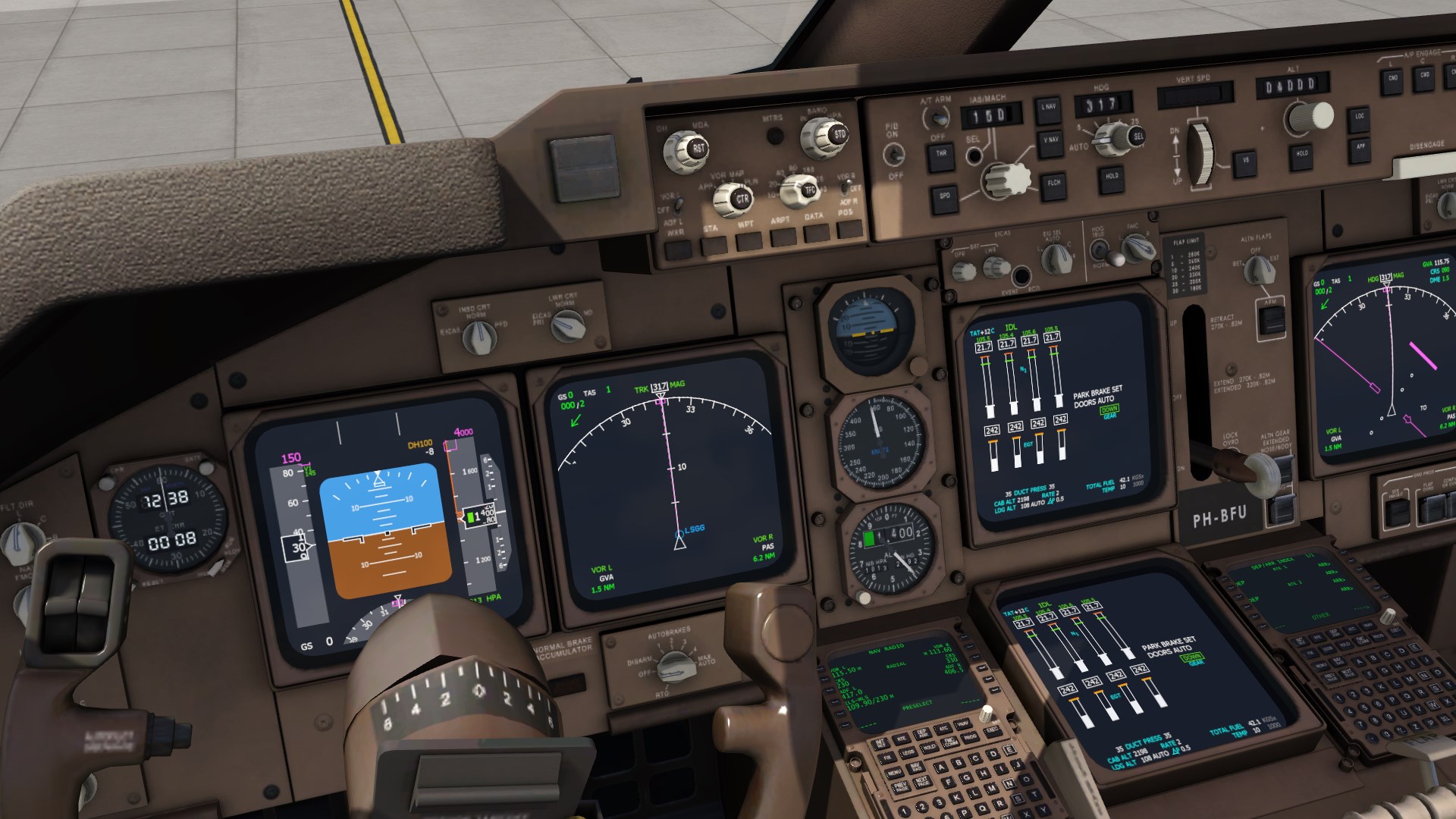
|
- Boeing 737 in AS2 has old-style instruments and a modern autopilot.
Lets you test flying as pilots did before glass cockpit!
Fig. Detail of Boeing 737 autopilot

|
Fig. Boeing 737 in AFS2
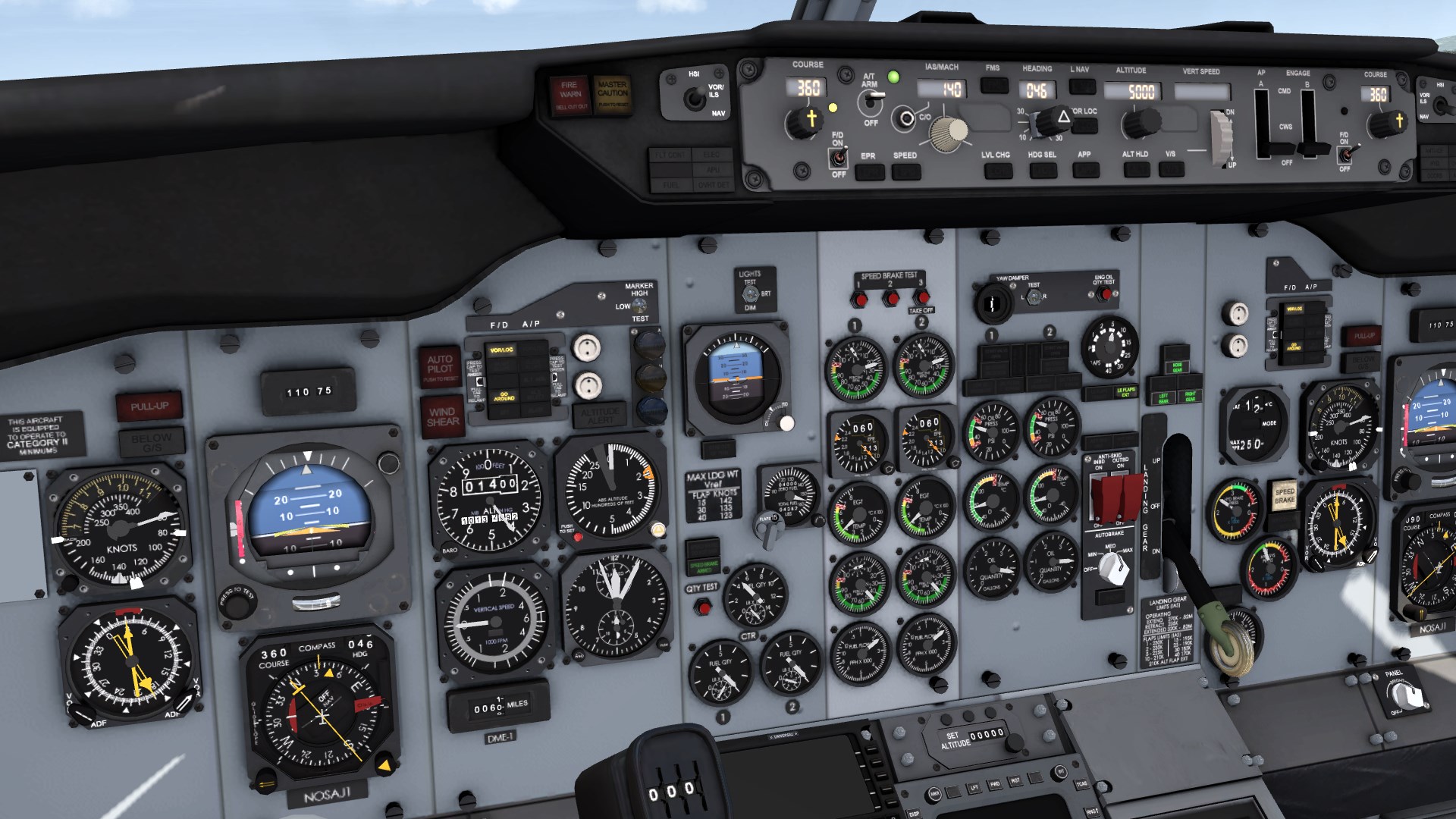
|
- |
Flight 5:
• Airbus 320 Beginners Tutorial, AFS2 Wiki
- very pedagogic and shows AP's advanced features.
- main steps and flight plan shown here, the rest you find at AFS2 website.
|
Flight 5 from Sacramento to San Francisco.
- Start: Manual, significant speeds are displayed.
- Cruise: Autopilot follows track (GPS), and you set ALTS to 12000ft.
- Landing with ILS: Set ALTS to 2000ft. Autopilot computes Top of Descent (ToD),
tunes in and lands aircraft all the way to Rwy, with flare!
|
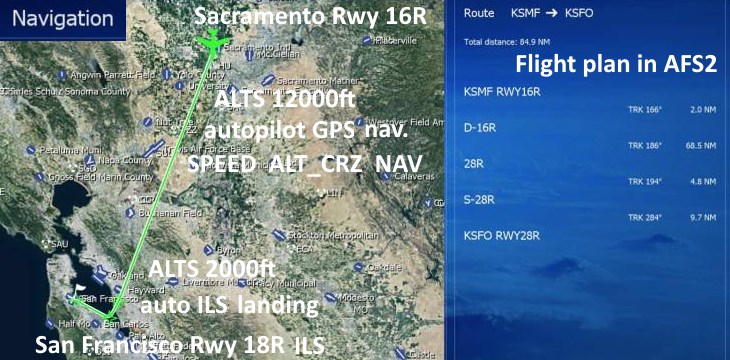
|
Panels for sims:
One can buy autopilot panels for simulators, to make your sim-flying more hands-on.
|
Fig. GoFlight Pro similar to Boeing 737 AP.
Just buy, plug-in, and play! But is not cheap!

|
Fig. Saitek panels are simpler and less expensive. Here autopilot and radio panels.
One has to use a knob (left) for different displays/settings:
 |

